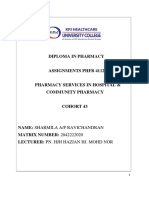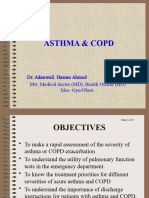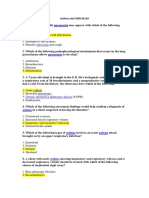Chapter - 031.bridge To NCLEX Review Question Answers
Uploaded by
Jackie JuddChapter - 031.bridge To NCLEX Review Question Answers
Uploaded by
Jackie JuddChapter 31
Obstructive Pulmonary Diseases
Bridge to NCLEX Examination – Answers to Test Questions
1. Correct answer: a
Rationale: If hemoptysis occurs, the patient should contact the HCP. In some patients, a spot of
blood is usual. The HCP should give specific instructions about when emergency contact is
needed. The other indicators listed are to be expected in the patient with bronchiectasis, and do
not need urgent medical attention.
2. Correct answers: a, b, c, e
Rationale: Airway clearance techniques include chest physiotherapy, positive expiratory
pressure devices, breathing exercises, and high-frequency chest wall oscillation systems.
Bronchodilators and mucolytics are an important part of this plan. Severe constipation can be
treated with polyethylene glycol (PEG) electrolyte solution, which is used to thin bowel contents.
Inhaled tobramycin is effective in patients with CF who have Pseudomonas infections.
3. Correct answers: b, c, d
Rationale: Allergic rhinitis is a major predictor of adult asthma. Acute and chronic sinusitis,
especially bacterial rhinosinusitis, may worsen asthma. The chronic inflammation of asthma
leads to recurrent episodes of wheezing, breathlessness, chest tightness, and cough, particularly
at night or in the early morning. GERD is more common in people with asthma than in the
general population. GERD may worsen asthma symptoms because reflux may trigger
bronchoconstriction and cause aspiration. Chest pain and syncope after five minutes of exercise
are not normal for the patient with asthma, and patient should be encouraged to report these
specific findings to their HCP for additional follow-up.
Copyright © 2023 by Elsevier, Inc. All rights reserved.
4. Correct answers: a, c, e
Rationale: Status asthmaticus is characterized by a lack of response to conventional treatment.
This is potentially a life-threatening medical emergency, which may require mechanical
ventilation in the ICU. As the patient is keenly aware that response to treatment is not working,
anxiety and panic may be observed. If the patient can speak in complete sentences, or, has a
PEFR >300L/min, then there is no immediate threat to the respiratory system. A chest x-ray with
hyperinflated lungs and a flattened diaphragm is strongly suggestive of COPD. A positive
sputum culture indicates lung infection.
5. Correct answers: a
Rationale: A rescue plan for patients with asthma includes taking 2 to 4 puffs of a short acting
bronchodilator (not a corticosteroid) every 20 minutes (3 times) to obtain rapid control of
symptoms. All other patient statements identify to the nurse that the patient has accurate
knowledge about his condition.
6. Correct answers: d
Rationale: The mainstay of acute asthmatic treatment is inhalation of short-acting β2adrenergic
agonist (SABA) bronchodilators, such as albuterol (ProAir HFA, Proventil HFA, Ventolin HFA).
In patients with a moderate to severe attack, inhaled ipratropium (Atrovent) is used in
conjunction with SABA. Salmeterol (Serevent Diskus) and montelukast (Singulair) are long-term
control medications. Inhaled hypertonic saline is used in cystic fibrosis and bronchiectasis to help
thin secretions. IV Theophylline is no longer recommended for the treatment of acute asthma
attacks or in COPD exacerbations because of a very narrow therapeutic window, the availability
of newer and more effective drugs, and, significant adverse effects (e.g., seizures and
dysrhythmias).
Copyright © 2023 by Elsevier, Inc. All rights reserved.
7. Correct Answers: a, c, e
Rationale: Breathing exercises may assist the COPD patient during rest and activity (e.g.,
lifting, walking, stair climbing) by decreasing dyspnea, improving oxygenation, and slowing the
respiratory rate. Walking (or other endurance exercises, such as cycling), combined with strength
training, when possible, are probably the best interventions to strengthen muscles and improve
the endurance of a patient with chronic obstructive pulmonary disease (COPD). Low dose oral
corticosteroids may be appropriate for chronic COPD patients. Frequent chest x-rays are not
needed.
8. Correct answer: d
Rationale: The patient needs to know the correct way to determine if the metered-dose inhaler
(MDI) is empty. The patient should divide the total number of puffs in the canister by the puffs
needed per day. The other three statements are not correct.
Answers to Case Study Discussion Questions
1. Recognize: What manifestations indicate H.M. had a COPD exacerbation?
Increased dyspnea, increased work of breathing (at rest) and a change in the color, amount, or
other characteristics of one’s sputum (e.g., becoming thick, purulent, when patient normally
expectorates thin, clear secretions).
2. Analyze: What is the most likely cause of her exacerbation?
Smoking and air pollution exposure as a police officer.
3. Analyze: Why would H.M. “feel full fast” when eating? What could you do to address this
issue?
Copyright © 2023 by Elsevier, Inc. All rights reserved.
Sensations of feeling full after consuming small amounts can be attributed to swallowing air
while eating, side effects of medication (especially corticosteroids), and the abnormal position
of the diaphragm relative to the stomach (in association with hyperinflation of the lungs).
4. Analyze: What symptoms indicate overuse of inhalers? Which drug would cause the symptoms
described?
“Jitters” and “racing heart”; the Ventolin HFA would be the primary cause.
5. Analyze: Interpret the ABG on admission and 24 hours post-admission. In comparing both
ABGs, do you see a pattern?
ABG in ED: Partially compensated respiratory acidosis:
pH: 7.34: low, thus acidosis (normal 7.35 to 7.45)
PaCO2: 59 mm Hg: high (normal 35 to 45 mm Hg), thus the cause of the acidosis
HCO3-: 27 mEq/L (normal 22 to 26 mEq/L): one point over normal, thus the kidneys
are just beginning to compensate by conserving bicarbonate and trying to bring the pH
to normal.
PaO2 68 mm Hg, she is hypoxemic (normal: 80 to 100 mmHg)
24 Hours after admission: pH: 7.30 (H.M.is becoming more acidotic)
PaCO2: 63 mmHg (increasing, indicating a worsening acidosis)
HCO3-: 29 (above normal, but not much change)
PaO2: 64 (continues to indicate hypoxemia).
This is described as an “acute-on-chronic” exacerbation, as evidenced by worsening acidosis
and hypoxemia, and relatively little change in bicarbonate.
6. Priority Decision: Based on the assessment data presented, what are the priority clinical
problems?
Copyright © 2023 by Elsevier, Inc. All rights reserved.
Impaired respiratory system function, nutritionally compromised, activity intolerance,
deficient knowledge, substance abuse (e.g., continued cigarette smoking)
7. Act: What is one suggestion you could make to H.M. that could halt the progression of her
COPD?
Stop smoking.
8. Act: What should you include in her discharge planning and teaching?
Several important priorities for discharge teaching and planning must be considered before
H.M. can return home. Most priorities will involve the nurse confirming existing knowledge,
enhancing with newer knowledge, and validating retention of new knowledge.
Activity:
Confer with HCP about pulmonary rehabilitation order, or, at minimum a one-time
consult with PT to develop home exercise program for patient.
Encourage daily walking with increasing time and distance.
Confer with HCP if patient qualifies for oxygen during exercise. Suggest a 6-minute walk
test.
Nutrition:
5 to 6 small meals per day with lower carbohydrate and calories from protein/fats
Nutritional supplements if tolerated
Weigh weekly; if weight trends downward, contact HCP
Oxygen Therapy:
Review O2 therapy with the patient and her husband. Include its purpose, how to safely
administer within the home setting, and re-ordering information. Assess the patient and
her caregiver for any questions.
Copyright © 2023 by Elsevier, Inc. All rights reserved.
Respiratory Medications:
Explain the action of the Ventolin HFA and how the symptoms she had were a direct
result of too much. Explain how the medication should be dosed.
Explain the purpose of Ipratropium HFA, and how this medication is also to be used.
Reinforce the use of the counter on the MDI. Ask the patient to show how she uses and
cleans her MDI and how she tells if it is empty (e.g., look at the counter).
Explain the Advair DPI diskus and have her show use. Explain the difference between the
DPI and MDI. Explain why mouth rinses are important after the Advair and provide
written points on the difference. Explain that the Advair will prevent her from having as
many exacerbations.
Explain that the long-acting β2-adrenergic agonists (LABA) should prevent night-time
dyspnea.
Other Medications:
Explain about Prednisone, and its role as a steroid in helping reduce inflammation in
COPD exacerbations.
Teach about Doxycycline, and its role in helping prevent repeated exacerbations in
chronic COPD. Ensure patient is aware that even though feeling better, it is important to
finish the full 10-day course of therapy.
Explain the purpose of Lasix, it’s role in helping in helping reduce the overall amount of
fluid in the body (including the lungs), to help breathe easier. Explain important adverse
effects of Lasix.
Other Important Teaching Points:
Copyright © 2023 by Elsevier, Inc. All rights reserved.
Teach and/or gently reinforce the patient huff coughing and pursed lip breathing. Give
written materials on these techniques and have her return the demonstration.
Discuss the cardinal symptoms of COPD exacerbation, including increased dyspnea,
increased volume and purulence of sputum, and what and when she should report to the
HCP.
9. Develop a conceptual care map for H.M.
Copyright © 2023 by Elsevier, Inc. All rights reserved.
You might also like
- Chapter 24 - Management of Patients With Chronic Obstructive Pulmonary Disease100% (3)Chapter 24 - Management of Patients With Chronic Obstructive Pulmonary Disease8 pages
- Immediate Management of Acute Severe AsthmaNo ratings yetImmediate Management of Acute Severe Asthma44 pages
- Questions: Chronic Obstructive Pulmonary DiseaseNo ratings yetQuestions: Chronic Obstructive Pulmonary Disease4 pages
- Diagnostic Studies: The Forced Expiratory Volume Over 1 Second (FEVNo ratings yetDiagnostic Studies: The Forced Expiratory Volume Over 1 Second (FEV7 pages
- (NS) AsthmaCOPDPneumonia Tutorial QuestionsNo ratings yet(NS) AsthmaCOPDPneumonia Tutorial Questions25 pages
- Faculty Marked Assignment 4 1 Semester SY: 2020-2021 Ncm112 - OxygenationNo ratings yetFaculty Marked Assignment 4 1 Semester SY: 2020-2021 Ncm112 - Oxygenation2 pages
- As A Cause of Death in The United States, COPD Ranks:: SecondNo ratings yetAs A Cause of Death in The United States, COPD Ranks:: Second9 pages
- Sas 4-Lung Inflation and Obstructive Airway DisordersNo ratings yetSas 4-Lung Inflation and Obstructive Airway Disorders3 pages
- Shortness of Breath: UNC Emergency Medicine Medical Student Lecture Series100% (1)Shortness of Breath: UNC Emergency Medicine Medical Student Lecture Series49 pages
- Concept Map # (Insert Student Name Here)No ratings yetConcept Map # (Insert Student Name Here)15 pages
- Respiratory Disorders Casebook - Part 2 by Dr. Nehad AhmedNo ratings yetRespiratory Disorders Casebook - Part 2 by Dr. Nehad Ahmed17 pages
- CN 112B - Unit III - Lower Respiratory Tract DisordersNo ratings yetCN 112B - Unit III - Lower Respiratory Tract Disorders97 pages
- Treatment of Emergency Cases Guidline Dr. Emal ShirzaiNo ratings yetTreatment of Emergency Cases Guidline Dr. Emal Shirzai104 pages
- Bahalag Kapoy Ang Hirap Dapat Tayu Ay Magsusumikap para Tayo Ay ManingkamotNo ratings yetBahalag Kapoy Ang Hirap Dapat Tayu Ay Magsusumikap para Tayo Ay Maningkamot32 pages
- Introduction To The Integrated Disease Surveillance ProjectNo ratings yetIntroduction To The Integrated Disease Surveillance Project26 pages
- Philippine Cancer Facts and Estimates 2010No ratings yetPhilippine Cancer Facts and Estimates 201087 pages
- Premature Ruptured of Membrane: Ferdian GunawanNo ratings yetPremature Ruptured of Membrane: Ferdian Gunawan29 pages
- Peripheral Intravenous Cannulation PolicyNo ratings yetPeripheral Intravenous Cannulation Policy14 pages
- Health & Safety Inspection - Cinnamon Red Kandy 04th August 2021No ratings yetHealth & Safety Inspection - Cinnamon Red Kandy 04th August 202110 pages
- Inadequate Self-Care Behaviors Among Malaysian DiaNo ratings yetInadequate Self-Care Behaviors Among Malaysian Dia5 pages
- Surveying Data Siblu Dam and ReservirosNo ratings yetSurveying Data Siblu Dam and Reserviros253 pages
- No Judul Publikasi Penulis Tahun Nama Jurnal/proceeding 1.: PressNo ratings yetNo Judul Publikasi Penulis Tahun Nama Jurnal/proceeding 1.: Press2 pages
- 667209502 Community Health Nursing Amjad BaigNo ratings yet667209502 Community Health Nursing Amjad Baig45 pages
- Lean Six Sigma Solutions For Quality Improvement in Healthcare Sector: A Systematic ReviewNo ratings yetLean Six Sigma Solutions For Quality Improvement in Healthcare Sector: A Systematic Review5 pages

























































































